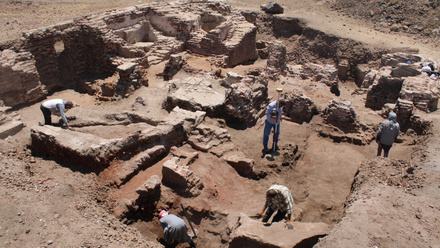The tomb of Usermontu (TT382)
The tomb of Usermontu (TT 382) is located in Qurnet Murei among the burials of other high-ranking officials dating from the 18th Dynasty through the Ptolemaic Period.

Photo showing the location of TT 382 in Qurnet Murei
The only remaining traces of the tomb, until 8 years ago, were two articles published in the 1930s and the red granite sarcophagus of Usermontu, which currently resides in The Metropolitan Museum of Art in New York.
In 2010, the tomb was re-discovered following the demolition of modern buildings in the area.

Excavation of the forecourt of TT 382 in 2010.

The entrance of TT 382 before the opening and re-discovery in 2010.
A brief survey of the wall scenes in Usermontu’s tomb suggests that it was built during the Ramesside Period; however, a lack of royal cartouches prevents dating to a specific king’s reign.
Usermontu held multiple important titles, including High Priest of Montu, Overseer of Cattle, and Overseer of the Treasury. It is not surprising, therefore, that his tomb is one of the largest in the area.
Aims and objectives of TT 382 project:
- To understand the stratigraphy of the debris filling the tomb.
- To find further information about Usemontu and the tomb’s dating.
- To find further information on the tomb’s re-use.
Proposed work
With the help of the EES Centenary Award (2018), work in TT 382 will concentrate on:
- Surveying the site and planning the tomb layout.
- Excavating the debris and clearing the tomb. With the help of a conservation team, the decorated plaster fragments will be preserved with the aim of restoring them to their original position where possible.
- An osteoarchaeologist will be on hand to properly examine the human remains for future study.
- Recording and analysing the artefacts discovered during the project.
- Removal and cataloguing of any ceramic material.
- Record, clean, consolidate, and study the wall scenes with the intention of discovering a more precise date for the tomb.

Fragments of painted plaster from the wall and the ceiling in the transverse hall mixed with human remains.

Debris within the tomb.

Usermontu and his wife adoring to different deities.

The titles of Usermontu, written in the lower register, north wall, longitudinal hall.



